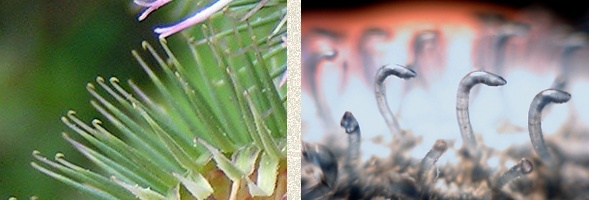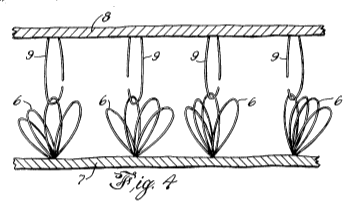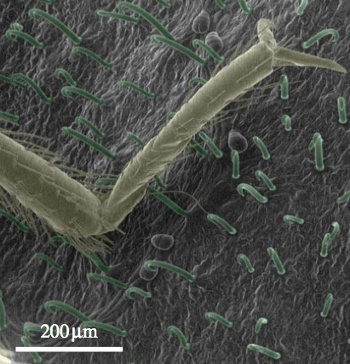Insect Velcro
April 22, 2013
Louis Pasteur is credited with the quotation, "
Chance favors a prepared mind."[1] I've experienced this myself when the results of an
experiment were not what I so fervently expected, but they led to an important discovery, at least in the "
normal science" meaning of important.
The Swiss
electrical engineer,
George de Mestral, noticed something interesting while
hunting in the
alps in 1941. He noticed how well
burdock burrs, which cover the
seeds of burdock as an aid to their
dispersal, stuck to his clothing.
Not letting such a
chance observation pass without an investigation of the mechanism, de Mestral used a
microscope to see that the burrs were covered with
hooked spines. He developed a
fastener based on the burdock principle, and received
patents for
Velcro™.[2] I wrote about the fiftieth
anniversary of Velcro in a
previous article (Fifty Years of Velcro, June 16, 2008).

Detail of the seed of the Arctium lappa (burdock), and the hooks of a piece of Velcro. (Source images, left and right, via Wikimedia Commons. Right image by Flickr User Olivepixel.)
De Mestel's
trade name for his invention, Velcro, was derived from a combination of two
French words,
velours (
velvet) and
crochet (hook). As is typical for important inventions, expiry of the Velcro patent in 1978 unleashed a flood of like products into the world. The original Velcro US patent is currently cited by 116 other US patents.[2]
Not just useful for clothing fasteners, Velcro keeps object in place. The
US space shuttles contained hundreds of
feet of
Teflon-
polyester Velcro strips to hold objects in
weightlessness.
Vulcan Velcro (Vulcro?) is an important
plot element in an episode of
Star Trek: Enterprise (
Carbon Creek, Season 2, Episode 2, September 25, 2002).

Figure four of US Patent No. 3,009,235, 'Separable Fastening Device,' by George de Mestral, November 21, 1961.
(Via Google Patents.[2]
A team of
scientists from the
Department of Chemistry and the
Department of Ecology and Evolutionary Biology of the
University of California, Irvine, and the
Department of Entomology, the
University of Kentucky (
Lexington, KY), have followed-up on a
Balkan old wives prescription for ridding a
residence of
bedbugs.[3-6]
According to the
folk practice, bedbugs are trapped on the surface of
kidney bean leaves placed on the floor next to beds. The leaves are later collected and burned.[4] There were a few
publications about this method, including a 1927 paper by a
German entomologist, and a 1943 paper by a scientist at the
United States Department of Agriculture.[5]
The motivation for this research is easy to understand, since there's been a resurgence of
bedbug infestation in the US. The insect's ability to breed rapidly and "hitchhike" from place to place make their
extermination difficult. The established extermination methods include
chemical pesticides,
freezing,
heating, and
vacuuming. Chemicals have their
toxicity, the bugs have developed
pesticide resistance, and the other methods are expensive.[4]
By using
scanning electron microscopy and
videography, the research team found that the mechanism is not the Velcro mechanism; rather, there's a
physical impaling of bedbug feet (called tarsi) by the hairlike
trichomes on a leaf surface. The initial capture happens in just a few seconds; and, in their struggles to free themselves, the bedbugs are impaled by other trichomes.[3-4]] There is a similarity to Velcro, however, in the hooks at the ends of the trichomes (see
photomicrograph).[4]

Photomicrograph of a bedbug leg trapped by the hairlike trichomes on a leaf surface.
Although the US Irvine study focused on bedbugs and kidney bean leaves, other plants have insect-trapping trichomes.
(University of California Irvine image by M. Szyndler and C. Loudon.)[4)]
Not all regions of the leg are pierced by the trichomes; rather, it is only the thinner areas of the
exoskeleton where the legs flex and the claws protrude.[5] Close microscopic examination of the impaling process showed that it happens as the foot is lifted, since the hooks point downwards.[5] The trichomes and their hooks are located at an optimal height for the impaling.[3]
Kidney bean leaves could be
cultivated for this purpose; but, as all leaves, they dry out and lose effectiveness. Also, they can't be applied easily to areas other than the floor.[4] The next step was some
materials engineering to create a surface that
mimics kidney bean leaves, so the research team
microfabricated materials with surfaces that closely resembled the leaf surface. A
casting process was used with a variety of
polymers.[5]
Unfortunately, the artificial leaves are not as effective. They entrap the bedbugs just temporarily. The bugs could walk 39 steps on average before being snagged, but their exoskelton was never pierced, and they moved on.[3,5] This suggests that the
mechanical stiffness of the artificial trichomes needs to be optimized.[4-5]
Says
Michael Potter of the University of Kentucky,
"Nature is a hard act to follow, but the benefits could be enormous...Imagine if every bedbug inadvertently brought into a dwelling was captured before it had a chance to bite and multiply."[4]
A patent is pending on this technology, which has garnered the interest of a company for possible commercialization.[5] Funding for the study was provided by the
National Science Foundation.[3-4]
References:
- "Dans les champs de l'observation le hasard ne favorise que les esprits préparés".
- George de Mestral, "Separable Fastening Device," US Patent No. 3,009,235 (November 21, 1961).
- Megan W. Szyndler, Kenneth F. Haynes, Michael F. Potter, Robert M. Corn and Catherine Loudon, "Entrapment of bed bugs by leaf trichomes inspires microfabrication of biomimetic surfaces," J. R. Soc. Interface, vol. 10 no. 83 (April 10, 2013), Document No. 20130174.
- Bean leaves can trap bedbugs, researchers find - Next step is to perfect synthetic materials that can do the same, University of California Irvine Press Release, April 9, 2013.
- Felicity Barringer, "How a Leafy Folk Remedy Stopped Bedbugs in Their Tracks," The New York Times, April 9, 2013.
- Kate Loudon (UC Irvine ecology & evolutionary biology), "Bean leaves can trap bedbugs," YouTube Video, April 9, 2013.
Permanent Link to this article
Linked Keywords: Louis Pasteur; chance favors a prepared mind; experiment; The Structure of Scientific Revolutions; normal science; electrical engineering; electrical engineer; George de Mestral; hunting; Swiss Alps; Arctium; burdock; burr; seed; seed dispersal; dispersal; serendipity; chance observation; microscope; hook; fastener; patent; Velcro™; anniversary; Arctium lappa; Wikimedia Commons; trade name; French language; velours; velvet; crochet; US space shuttle; foot; polytetrafluoroethylene; Teflon; polyester; weightlessness; Vulcan; plot; Star Trek: Enterprise; Carbon Creek; Google Patents; scientist; Department of Chemistry; Department of Ecology and Evolutionary Biology; University of California, Irvine; Department of Entomology; University of Kentucky; Lexington, KY; Balkans; old wives' tale; residence; bedbug; folk practice; kidney bean; scientific literature; scientific publication; German; entomologist; United States Department of Agriculture; bedbug infestation; pest control; extermination; chemical compound; pesticide; freezing; heating; vacuuming; toxicity; pesticide resistance; scanning electron microscopy; videography; physical impaling; trichomes; photomicrograph; M. Szyndler; C. Loudon; exoskeleton; horticulture; cultivation; materials engineering; biomimicry; microfabrication; microfabricated; casting; polymer; mechanical stiffness; Michael Potter; Nature; National Science Foundation; "Dans les champs de l'observation le hasard ne favorise que les esprits préparés"; George de Mestral, "Separable Fastening Device," US Patent No. 3,009,235 (November 21, 1961).